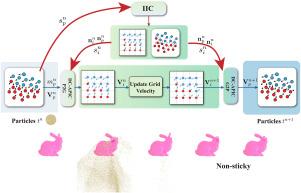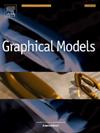DC-APIC:在MPM中非粘性固-液相互作用的细胞转移方案中分解的兼容仿射粒子
IF 2.2
4区 计算机科学
Q2 COMPUTER SCIENCE, SOFTWARE ENGINEERING
引用次数: 0
摘要
尽管材料点法(MPM)为不同材料的耦合提供了统一的粒子模拟框架,但MPM存在粘性数值伪影,固有地局限于粘性和无滑移相互作用。本文在MPM框架下,提出了一种新的可分解兼容仿射粒子单元(DC-APIC)传输方案,用于模拟统一背景网格下自由滑移边界条件下弹性固体与不可压缩流体之间的双向耦合相互作用。首先,我们采用颗粒-网格相容性来描述流固界面上网格节点与颗粒之间的关系,为后续颗粒-网格-颗粒转移提供指导。然后,我们提出了一种相场梯度法来跟踪界面处的相容性和法线方向。其次,为了方便固流耦合过程中MPM碰撞自动解决,在本文提出的DC-APIC积分器中,切向分量不会在不兼容的网格节点之间转移,以防止另一阶段的速度平滑,而法向分量的转移没有限制。最后,我们的综合结果证实,与传统的MPM相比,我们的方法有效地降低了扩散和非物理粘度。本文章由计算机程序翻译,如有差异,请以英文原文为准。

DC-APIC: A decomposed compatible affine particle in cell transfer scheme for non-sticky solid–fluid interactions in MPM
Despite the material point method (MPM) provides a unified particle simulation framework for coupling of different materials, MPM suffers from sticky numerical artifacts, which is inherently restricted to sticky and no-slip interactions. In this paper, we propose a novel transfer scheme called Decomposed Compatible Affine Particle in Cell (DC-APIC) within the MPM framework for simulating the two-way coupled interaction between elastic solids and incompressible fluids under free-slip boundary conditions on a unified background grid. Firstly, we adopt particle-grid compatibility to describe the relationship between grid nodes and particles at the fluid–solid interface, which serves as the guideline for subsequent particle–grid–particle transfers. Then we develop a phase-field gradient method to track the compatibility and normal directions at the interface. Secondly, to facilitate automatic MPM collision resolution during solid–fluid coupling, in the proposed DC-APIC integrator, the tangential component will not be transferred between incompatible grid nodes to prevent velocity smoothing in another phase, while the normal component is transferred without limitations. Finally, our comprehensive results confirm that our approach effectively reduces diffusion and unphysical viscosity compared to traditional MPM.
求助全文
通过发布文献求助,成功后即可免费获取论文全文。
去求助
来源期刊

Graphical Models
工程技术-计算机:软件工程
CiteScore
3.60
自引率
5.90%
发文量
15
审稿时长
47 days
期刊介绍:
Graphical Models is recognized internationally as a highly rated, top tier journal and is focused on the creation, geometric processing, animation, and visualization of graphical models and on their applications in engineering, science, culture, and entertainment. GMOD provides its readers with thoroughly reviewed and carefully selected papers that disseminate exciting innovations, that teach rigorous theoretical foundations, that propose robust and efficient solutions, or that describe ambitious systems or applications in a variety of topics.
We invite papers in five categories: research (contributions of novel theoretical or practical approaches or solutions), survey (opinionated views of the state-of-the-art and challenges in a specific topic), system (the architecture and implementation details of an innovative architecture for a complete system that supports model/animation design, acquisition, analysis, visualization?), application (description of a novel application of know techniques and evaluation of its impact), or lecture (an elegant and inspiring perspective on previously published results that clarifies them and teaches them in a new way).
GMOD offers its authors an accelerated review, feedback from experts in the field, immediate online publication of accepted papers, no restriction on color and length (when justified by the content) in the online version, and a broad promotion of published papers. A prestigious group of editors selected from among the premier international researchers in their fields oversees the review process.
 求助内容:
求助内容: 应助结果提醒方式:
应助结果提醒方式:


